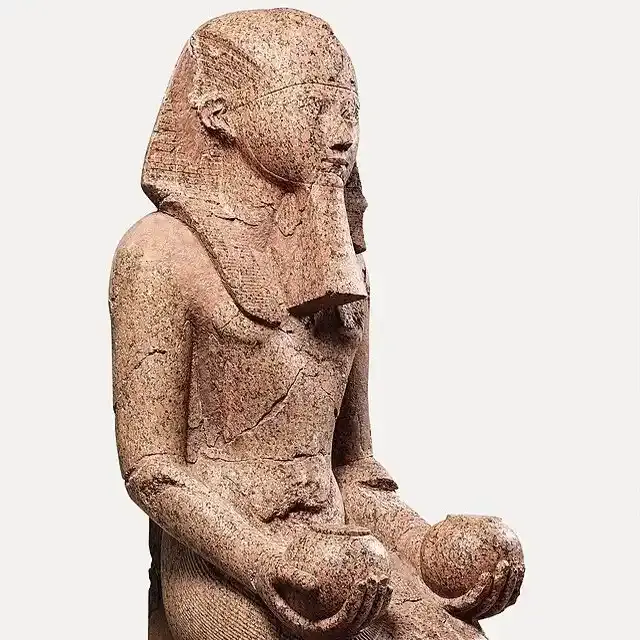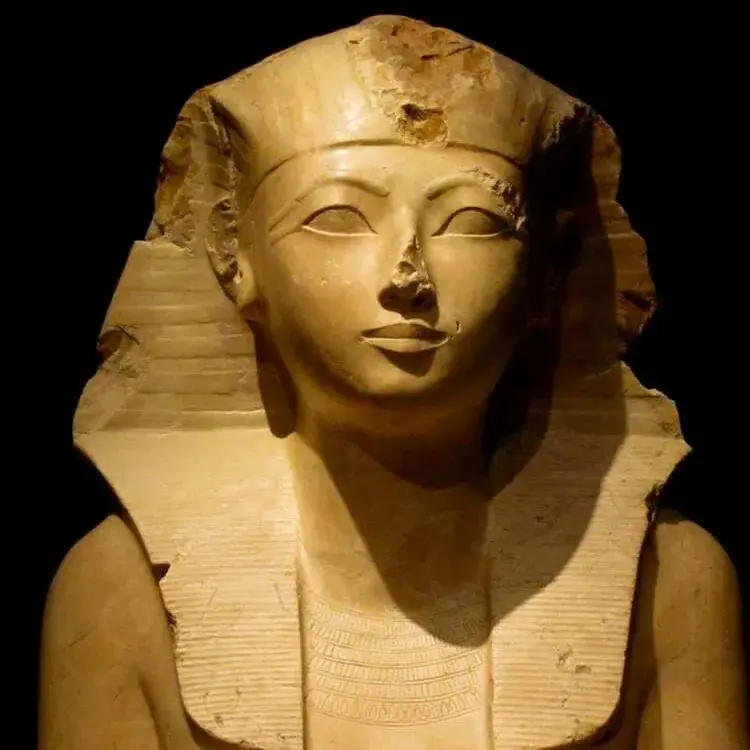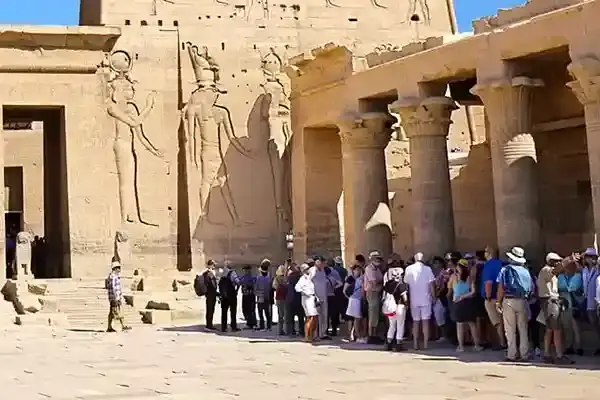One of history’s most intriguing figures was Hatshepsut, also one of ancient Egypt’s most successful trailblazing pharaohs who broke societal norms to take the throne. She was an outstanding ruler - a strong leader, with visionary policies and a prolonged devotion to Egypt's culture and religion. In this article, we delve into her life, reign, accomplishments, and legacy in order to answer these questions about her contribution to history and why she was erased from the records. So, What did Hatshepsut do to secure her place in history despite attempts to erase her? Let's discover.
Table of contents [Show]
Who Was Hatshepsut?

Hatshepsut was an impressive woman in Ancient Egypt, one of the few women to make it up the throne as a pharaoh. What did Hatshepsut do to achieve this? We will answer in the following section.
Hatshepsut was born around 1507 BCE to Pharaoh Thutmose I and Queen Ahmose, as a member of Egypt’s Eighteen Dynasty, which was notorious for its prosperity and considerable cultural achievements.
We invite you to take a look at our beautiful Trip look and see the offers 8 Days Cairo, Luxor, Aswan Classic Tours
1- Background - Hatshepsut's Early Life and Family
Hatshepsut was Egypt's fifth pharaoh of the 18th Dynasty, famous as one of the very few women to be ennobled to the powerful role of pharaoh. A daughter of Pharaoh Thutmose I and Queen Ahmose, she enjoyed an exceptional position in the kingdom by reason of her royal lineage. What did Hatshepsut do during her early life to rise to such prominence?
Initially, Hatshepsut was a great royal wife to her half-brother, husband, and predecessor Thutmose II. This was normal among the royal family to strengthen political alliances and protect the royal bloodline.
2– Hatshepsut Transition to Power
Then, after her husband's death, she became regent to his stepson, Thutmose III who was too young to rule. What did Hatshepsut do next? Hatshepsut went further and in a very unprecedented move declared herself pharaoh around 1473 BCE.
3– Legitimizing Her Reign
Very rarely were there female rulers of Ancient Egypt, so Hatshepsut had to have had excellent political and religious justification to take the throne. So, What did Hatshepsut do to justify her reign?
She declared herself divine, saying that it was Amun who was her true father. She further adopted full the regalia and titles of the male king, including a false beard, and traditional headdress. It was not a symbolic gesture, but it was a well-thought-out political strategy to legitimize her rule in a society where all leadership was male. In her portrayal, she balanced the traditional male imagery with subtle feminine touches.
— Visit Egypt’s timeless wonders in eight days with 8 Days Cairo, Luxor, Aswan Classic Tours . See the amazing Luxor Hatshepsut Temple alongside the Great Pyramids, Karnak Temple, and more! Start your adventure today!
When Did Hatshepsut Rule?
Hatshepsut is known to have reigned over Egypt during the 18th Dynasty, from probably about 1479 to 1458 BCE. What did Hatshepsut do to make her reign so significant? One of the reasons that makes her era so important is that she reigned for most of 21 years, leaving her one of Egypt's longest-serving female pharaohs. She began her reign as regent for her infant son, Thutmose III, after the death of Thutmose II, her late husband. Little by little, she climbed the ladder of regent to pharaoh – without precedent for a woman in Ancient Egypt.
Maybe like our trip: 8 Days Cairo to Abu Simbel and Back Overland
Timeline of Events During Hatshepsut Reign:
1479 BCE: Hatshepsut becomes regent for Thutmose III upon his father Thutmose II’s death.
1473 BCE: Around 1473 BCE she declared herself a pharaoh and conducted the famous expedition to the Land of Punt, hugely increasing Egypt’s wealth and power.
1458 BCE: Her rule most likely ended in 1458 BCE with her death.
What Was Hatshepsut Known for?

Hatshepsut is most famous for her great achievements as a female pharaoh of a male-dominated culture in Egypt. What did Hatshepsut do to stand out? It was a rather long reign that saw much stability, prosperity, and huge accomplishments. She strengthened trade relationships with other countries; her most famous journey was to Punt to get wealth and diversified goods. She also left such architectural masterpieces as the mortuary temple at Deir el-Bahri, fascinating by its design and, especially, the friezes.
— Egypt Online Tour is here to help you plan your dream trip. Discover the history and astonishing beauty of Egypt in classic adventures or luxury tours. Book your journey today!
What Did Hatshepsut Do?
When Hatshepsut came to power, she redefined Egypt’s political, economic, and cultural landscape with groundbreaking achievements. What did Hatshepsut do differently from many of her predecessors and successors?
Unlike many of her predecessors and successors, who placed military conquests first, Hatshepsut’s reign was relatively peaceful, and she made relatively few military campaigns by comparison. She instead continued her focus on internal development, trade expansion, and monumental architecture.
Read about: Did Thoth Built The Pyramids
Trade and Economic Achievements
The expedition to Punt, a land believed to be in modern-day Eritrea, or Somalia, was Hatshepsut’s most notable achievement. What did Hatshepsut do to make this mission successful? This trade mission brought back precious goods, like gold, incense, myrrh, frankincense, ebony, and many other exotic animals that boosted Egypt’s economy and prestige.
Architectural Contributions
Hatshepsut built many temples, monuments, and statues, the best known of which being the Mortuary Temple of Hatshepsut at Deir el-Bahri. Its terraced design and beautiful style reliefs testify to her vision and artistic sensibilities.
Religious Leadership
She declared herself the “God’s Wife of Amun,” combining religious and political power. What did Hatshepsut do to strengthen her divine rule? She invented ceremonial practices to shore up the divine side of her rule.
Governance and Domestic Policies
Besides these other achievements, Hatshepsut additionally expanded the Egyptian economy by developing agriculture and ensuring food security. What did Hatshepsut do to improve the lives of her people? She made her people live better, with a time of stability and development, with her reign being a golden age in Egypt’s history.
In Egypt, there is a new museum that will open soon Do not wait to see Grand Egyptian Museum Tour
What Was Hatshepsut's Religion?

Hatshepsut practiced religious beliefs that were very deeply rooted in the polytheistic traditions of Ancient Egypt. She was a devoted follower of Amun, the chief deity of the time.
What did Hatshepsut do to use religion as a political tool?
She claimed that Amun had chosen her for himself to be his earthly representative. Her divine birth is shown on reliefs in her mortuary temple as Amun visits her mother in the form of her father, Thutmose I. This story helped to confirm her place as the divinely ordained ruler.
What did Hatshepsut do additionally to emphasize her religious dedication?
She gave the upper priority to the construction of temples for Amun, ensuring that his cult flourished as her mortuary temple was constructed to be the sanctuary for Amun.
She also expanded the Karnak Temple complex which was extended by chapels and obelisks dedicated to the god Amun.
— Discover Egypt’s treasures in a five-day trip with 5 Days Cairo to Luxor Tour Packages . Your adventure awaits from some of Cairo’s ancient wonders to Luxor’s majestic Hatshepsut Temple. Plan your trip now!
What Happened after Hatshepsut Died?
After Hatshepsut died around 1458 BCE her stepson and successor, Thutmose III, became king. At first, he seemed to recognize her role, but over time attempts were made to erase her footprint. But what did Hatshepsut do that caused her successors to erase her legacy?
Her unprecedented rule as a female pharaoh challenged societal norms, prompting efforts to remove her from history. Hatshepsut's statues were defaced, her name was removed from monuments, and records of her reign were deleted.
In fact, this systematic erasure - often called damnatio memoriae - was done to restore the traditional pharaonic male lineage.
All this, however, would not prevent Hatshepsut’s legacy from remaining. Recently, modern archaeological discoveries and scholarly research have revealed her tremendous achievements and put her back in her rightful place in history with her name among Ancient Egypt’s greatest rulers.
What Did Hatshepsut Take to The Afterlife?

Hatshepsut was a believer in the afterlife, like most of the Ancient Egyptians. What did Hatshepsut do to prepare for eternity? To assure her journey to the afterlife she constructed a grand tomb in the Valley of the Kings. Treasures, offerings, and amulets to protect and sustain her in eternity were buried with her in her burial chamber.
In fact, Hatshepsut’s mortuary temple at Deir el-Bahri was also part of her afterlife preparations. In addition to being a place of worship, this temple was a place where offerings could be made to honor her spirit.
In the inscriptions and artifacts found in her tomb and temple, we find her devotion to Amun and her belief in a harmonious union with the divine in the afterlife.
— Go back in time with Egypt Classic Tours . Immerse yourself in history as you take it in from Luxor’s ancient wonders to the Pyramids of Giza. Book your journey today!
Why Was Hatshepsut Removed from History?
The removal of Hatshepsut from historical records was a carefully planned thing to do to maintain a patriarchal dominance in the pharaonic lineage. Her successor, Thutmose III, ordered her statues destroyed and had her name erased from official records.
What did Hatshepsut do to provoke this erasure?
It seems that the motivation for this act of damnatio memoriae has been essentially political and ideological rather than personal.
To be able to represent himself as the sole legitimate king after Thutmose II, Thutmose III eliminated traces of Hatshepsut’s rule. This was helpful to enable him to emphasize his achievements and rewrite history so that it would be seen as uninterrupted and traditional.
In addition, subsequent rulers reattributed her achievements to male predecessors to continue the male pharaonic lineage and reaffirm male supremacy.
— Enjoy a touch of luxury as you Discover Egypt’s treasures. With our Egypt Luxury Tours, you experience elegance, comfort, and access to the country’s most magnificent sights. Start your luxurious journey right now!
Maybe like: Is The Sphinx Older Than The Pyramids
Hatshepsut Accomplishments

1- What did Hatshepsut do to enhance Egypt’s wealth? - Economic Achievements
She activated trade routes, primarily with the Land of Punt.
Myrrh, gold, and exotic animals were imported, all of which enriched Egypt’s economy.
2- What did Hatshepsut do to leave a lasting mark? - Architectural Contributions
Constructed the Temple of Deir el-Bahari, one of ancient design's masterpieces.
She erected towering obelisks at Karnak Temple, to symbolize her devotion to Amun.
She initiated many construction projects and left a lasting architectural legacy.
3- What did Hatshepsut do to create a golden age? - Governance and Policies
She ensured domestic prosperity and was concerned with peace and stability.
She promoted agricultural development as well as efficient administration.
She created a flourishing cultural environment, into which art and literature flourished.
Read more: When Did Ancient Egypt Start and End
Conclusion
Hatshepsut’s story is a story of resilience, innovation, and a long-lasting legacy. What did Hatshepsut do to defy convention? She was a female pharaoh in a male-dominated society, so she defied convention but showed exceptional leadership. In peace, prosperity, and long-lasting monuments, her reign stands out as evidence of her vision and ability.
Though her memory has been erased, her achievements have held the test of time and are rediscovered by modern archaeology and scholarship.
To this day she remains an inspiration, a symbol of what can be achieved by determination and ingenuity - a reminder of how a legacy can shape human history.
Frequently Asked Questions
1 What did Hatshepsut accomplish? ▶
2 Which Egyptian queen was removed from history? ▶
Popular Categories
Related tours
Cairo, Aswan, and Luxor
-
Starting From
$ 2,850
-
Type
Package
Cairo, Aswan, and Luxor
-
Starting From
$ 5,900
-
Type
Package
Cairo, Aswan, and Luxor
-
Starting From
$ 1,600
-
Type
Package
Cairo, Aswan, and Luxor
-
Starting From
$ 1,850
-
Type
Package











